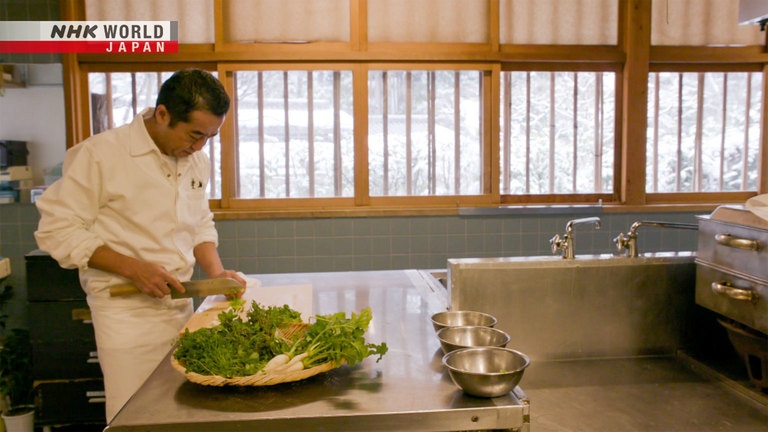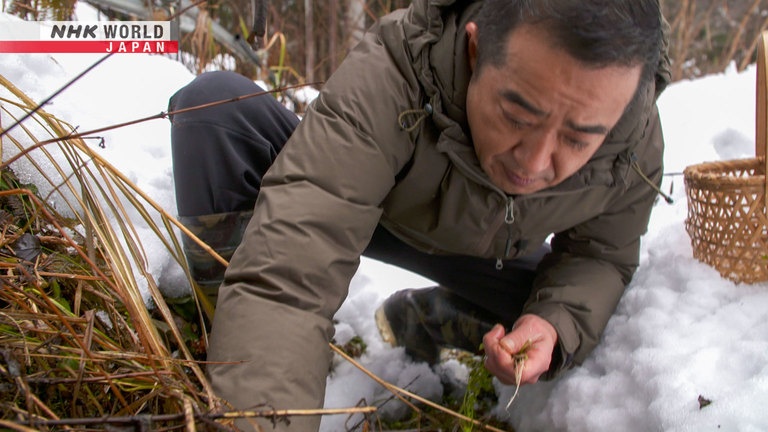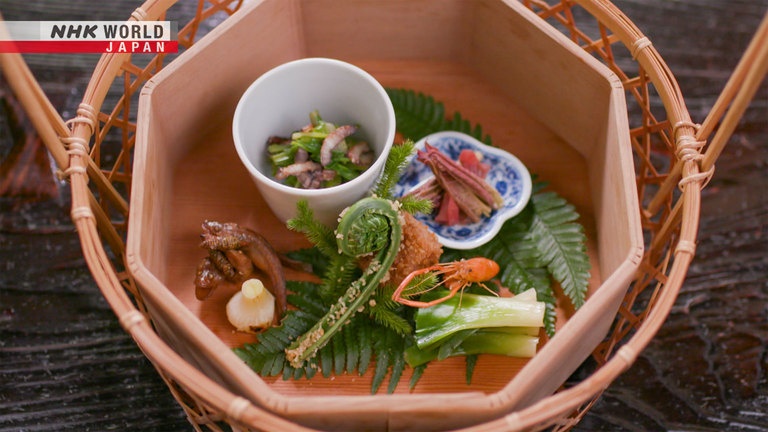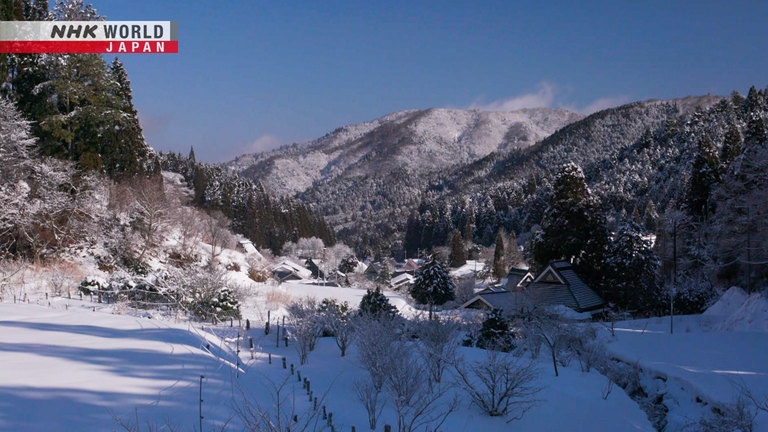Kyoto Foraging Master - Nakahigashi Hisato
Near Kyoto, in the mountain village of Hanase, is a traditional inn with 130 years of upholding approaches to cuisine and hospitality attuned with the rich local nature and the passage of the four seasons. It is run by fourth-generation head Nakahigashi Hisato, whose refined take on wild food and foraging has made fans of some of the world's leading chefs. We follow Nakahigashi through the winter months and gain unique insights into his pioneering update on time-honored culinary lore to suit modern tastes.




Transcript
"FRONTRUNNERS"
Wild vegetables are like my calendar.
To deliver satisfyingly nostalgic flavor,
you actually need to gradually evolve.
I don't plate things in rigid patterns.
Nature taught me everything I know.
KYOTO FORAGING MASTER
NAKAHIGASHI HISATO
Ninety minutes' drive from central Kyoto...
lies Hanase, a sleepy mountain village with a population of just 200.
It's also home to a traditional inn with 130 years of history.
(January 5, 2023)
Morning, everyone.
Another new year, huh?
It's the first day of work for the new year.
Happy New Year, everyone.
Last year was tough, due to COVID.
Fourth-generation owner Nakahigashi Hisato
upholds the inn's tradition of wild food and foraging.
Thanks in advance for another year.
At the entrance are traditional New Year's decorations,
including this local one made from an uprooted pine sapling.
Here, Nakahigashi's wife Sachiko wraps pieces of mochi rice cake
along willow branches to resemble rice stalks.
A prayer for plenty in the year ahead.
The inn has only four guest rooms.
But it has fans among Japan's cultural elite,
as well as internationally renowned chefs such as Alain Ducasse.
It's constantly fully booked a year in advance.
How wonderful!
Everything I'd hoped for.
The decorative "tokonoma" alcove in this room
features a celebratory crane motif.
Look, they're a couple, too!
The scroll was specially chosen for these guests.
(January 7, 2023)
I'm constantly walking around with my head down, to see what I can find.
These are quite big.
They've been spared by the deer.
We call these "tazeri."
They're a kind of dropwort that often grows in patches around rice paddies.
That smells lovely.
The kind of aroma that does your body good.
And one that builds your appetite for winter.
Ingredients like this, rich with the power of nature,
are the basis of Nakahigashi's wild food cuisine,
termed "Tsumikusa ryori."
"Nanakusa gayu" is a rice porridge made with seven herbs.
And Nakahigashi sees this dish as the starting point for his wild food ethos.
You start the year with a dish made from the first shoots of spring.
And these herbs have a genuine purifying effect on the body.
That flushes out all the impurities
and sets you up for good health in the year to come.
That's the thinking behind the Japanese tradition
of eating nanakusa gayu on January seventh.
The simple dish is seasoned only with salt.
Looks great.
It should set us all up for another year of giving our all to serving our guests.
For staff, this is an annual ritual.
Bless this meal.
To Nakahigashi, it's important that the whole team gets a feel
for the natural rhythm of the seasons in Hanase.
11 am, and lunch preparations are underway.
But Nakahigashi heads outside.
Time to catch some koi!
Winter is when koi carp are at their tastiest.
Nakahigashi keeps his carp in a pond fed by a mountain stream.
Freshwater fish take on the taste of the local water they live in.
A perception as somewhat earthy tasting
means that koi are not generally seen as a delicacy.
But cultivation in pure mountain water resolves this,
imbuing them with a distinctive local flavor.
It's just another one of the many time-honored traditions that Nakahigashi upholds.
With tuna and so on,
the real fatty, sweet-tasting cuts are around the flanks.
With koi, they're below the skin.
Those cuts are nice and fatty.
Looks great!
Rather than being served as sashimi,
these cuts will first be aired on sheets of "konbu" kelp,
to add extra umami.
The dish is named "yorokonbu,"
a play on "yorokobu," which means happiness.
A celebratory New Year's plate with koi carp as its centerpiece.
The inn lies en route to Daihizan Bujoji,
a temple with around 1,000 years of history.
The surrounding slopes were once the training ground for mountain ascetics.
Pilgrims would come here to engage in prayer and austerities at one with nature.
And it was as a hostel for such visitors
that the inn was founded in the 1890s.
But it wasn't until the stewardship of Nakahigashi Hisato's father Kichiji
that the inn gained fame for its cuisine.
His Tsumikusa ryori approach fused Kyoto sophistication
with diverse wild ingredients from the surrounding hills.
In summer, Hanase's mountain streams provide ayu sweetfish.
The young fish have a delicate palate that can even be eaten raw.
Autumn, too, has its characteristic ingredients.
Wild chestnuts gathered in the mountains
are paired with freshly harvested rice.
And beyond the gourmands of Kyoto,
Kichiji's refined "Tsumikusa" cuisine
began to win admirers from around the world.
Born as the eldest heir to this tradition,
Hisato grew up surrounded by nature.
There were so many places to play on our way to school.
On the way home, if there were fish in the river we'd just get in there and catch them.
Then we'd make a little fire and cook and eat them there and then.
That was playtime to us.
But, straight out of high school,
he left the mountains and headed overseas.
Time spent working in three-star restaurants in France
helped him learn about the nation's famous cuisine.
French people take great pride in their country and their food.
I realized how that underpinned the global reach of French cuisine
and I tried to relate that to myself.
I thought I needed to learn more, and from there on,
my time in France gradually taught me the appeal of Japan.
And deep down,
I realized the fulfilment I could find by taking over the family business.
But shortly after, Kichiji passed away suddenly at the age of just 55.
Leaving Hisato, still only 28 himself, to take over the family business.
Assisted by a handwritten volume of advice left to him by his father.
Dear Hisato.
Nature is where the truth lies.
True culture never stems from going against nature.
This is a vital lesson to take with you, moving forward.
I sometimes like to look at this, not just when I'm feeling a bit lost.
I find it very soothing to read.
It helps me figure out what I need to do on the road ahead,
be that for the family inn, or for the local area.
That's what this book means to me.
(February 2023)
Each winter, Hanase is blanketed with snow.
We join Nakahigashi on a visit to a local partner.
Hi there.
How are the miso pickles doing?
Shintani Hisatoshi is a vital supplier for Nakahigashi's inn.
He provides pickles and fermented foods
served as part of their seasonal menu.
Let's see how they're getting on...
- Looks like they need a bit longer.
- Yep, I think so.
This daikon radish is still early in the pickling process.
Not so good.
Still tastes pretty raw.
I guess so.
Still that "half-done" taste.
I have some knotweed too.
- A bunch of barrels?
- Nope, just the one.
Oh, I see.
For centuries, local people have relied on preserved foods
like these pickled knotweed stems
to store and eat through the long Hanase winter.
This is the bark. A layer each at the top and the bottom.
Wow, so that's how it's done.
It's a trick I learned from a local granny.
Throughout spring, knotweed is a ubiquitous sight in the hills of Hanase.
Eaten fresh, it has a pleasantly delicate tang.
But, when picked in May and pickled,
it can be stored and eaten all year round.
Around here, when you have people over for a memorial service or whatever,
you might serve them this with their sake.
It's a typical side snack.
And Nakahigashi makes time-honored seasonal ingredients like these
the centerpiece of his winter menu.
To me, dried foods, dried fish, and salt pickles
are the essence of winter.
That's part of Japanese food culture,
and our job as culinary professionals is to present those
in a way that is appetizing for our guests.
He serves the knotweed pickles as part of a "takiawase" assortment.
First, he soaks them overnight to alleviate their saltiness.
Before blanching them in a "katsuo"-base stock.
If we overcook them, they'll lose their shape.
So that's something we try to avoid.
And these are served alongside other preserved winter staples from the Hanase area.
With each one cooked in a different kind of stock.
In Japan, we traditionally eat with chopsticks,
so you have to think in terms of individual mouthfuls.
That's an age-old approach, three centimeters.
Nakahigashi's presentation also takes its cues from nature.
In nature, you see all these trees and plants mingled together.
I see that as a kind of order and purity
that I try to reflect in the way I present my dishes.
Nature taught me everything I know.
And Hanase has another quintessential winter dish.
- Good to see you.
- Hi there.
Wild-caught game. Boar is a staple winter catch for local hunters.
Shimohata Kanzo is renowned locally as a master hunter.
This is the only time of year when boar have their fat reserves.
From November to February or so.
Such deft knifework!
Well, you have to take care not to cut off the fat.
He takes care to salvage every last edible morsel.
It's a question of gratitude to the mountains for giving us these foods.
And this gratitude is reflected in the sharing of the meat.
Thanks very much.
Right, let's tuck in!
Thank you, everyone.
These evening get-togethers are the best part of hunting.
These days in the cities, people go out and buy their food.
But to me, genuine winter food is about deer and boar.
Another example of foods that can only be enjoyed in the mountains.
You can't beat the taste of firewood.
Nakahigashi decides to make this boar meat
the focus of a new culinary experiment.
What exactly is he searching for?
Earth. For my seasonal wild boar dish.
I'm going to make little earthen parcels
and bake those in the oven with the meat wrapped up inside.
That's the idea.
Back at the inn, he carefully washes the earth he collected...
before heating it in a pan.
Smells nice and earthy.
The aim is to impart some of this earthiness to the meat.
Of course, wild boar thrive by eating leaves and roots and bugs from the soil.
So, it's about reflecting Hanase's natural cycles in our dishes.
And Nakahigashi's junior staff, too,
are enthralled by this new experiment.
The boar meat is cooked in oil at a low heat until tender.
Then topped with a chutney made of "sansho" pepper,
burdock, konbu and honey,
Nakahigashi's secret recipe...
before being parceled up in a lotus leaf.
Now for the mountain soil.
Mixed with egg white to aid adhesion,
the soil is packed around the parceled-up meat.
And finally, the resulting packages are baked in the oven.
This steams the meat, while imparting subtle earthy notes.
If our guests are going to come all this way,
we can't just serve them the same dishes they'd get in the city.
So, we have to create dishes with a distinctive story behind them
that reflects the heritage of Hanase.
After 45 minutes, it's time to inspect the results.
Has this new experiment been a success?
Here goes.
Looking good.
You can smell the lotus leaves and the soil.
I'm glad it came out so well.
It's good.
The taste of hibernation, if that's not a bit abstruse.
Umezawa, can I cover you while you give this a try?
Umezawa Ryutaro is in his fourth year working in Nakahigashi's kitchen.
It really has that Hanase feel.
But what is it that drives Nakahigashi's experimentation with new dishes?
To deliver satisfyingly nostalgic flavor,
you actually need to gradually evolve.
If you just keep things the same as they always were,
they'll only rate you a six out of ten.
But by giving 120 or 130%, maybe you can make that a nine out of ten.
Every era evolves, so we have to do that too.
Good morning.
Nakahigashi is welcoming a group of staff and students
from Kyoto University of the Arts.
He's joined by pickle maker Shintani Hisatoshi to teach the students
how to make a traditional dish using another local ingredient.
Butterbur sprouts are a mountain shrub that heralds the coming spring.
You pull up the root to this stem, then just snip it off like so.
Then you trim off a little more.
That makes our kitchen prep easier.
They'll be using these butterbur to make a characteristic Hanase dish.
What a beauty!
Amazing that all this is under the snow.
Wow, look at that!
Their foraging complete, they head down to Nakahigashi's inn.
Here's today's harvest.
I bet this is your first time.
First, we trim off the hard, dirty exterior.
So, I'd like you all to help with that.
Today, they'll be making butterbur miso.
It's a dish that all Hanase locals will have enjoyed at their grandmother's table,
but the tradition is gradually being lost.
That has a kick.
Not for me, thanks.
Faced with the slow decline of Hanase home cooking...
Nakahigashi is aiming to promote these dishes commercially
as local specialty items.
In the hope that this can inspire a new generation
to learn the traditional techniques.
It smells totally different.
Edible at last!
And having spent the day in this butterbur miso workshop...
It's lovely with white rice.
The students design labels
that they hope will help to market this local soul food.
Moving forward, Nakahigashi aims to promote a range of local staples
in order to keep the flame of Hanase home cooking alive.
What is it that motivates him as a "frontrunner" in his field?
I want to make sure Hanase is known as a village with rich food resources.
Unique ingredients underpinning dishes that you can't enjoy anywhere else.
Slow food and so on.
That's the context I want to create.